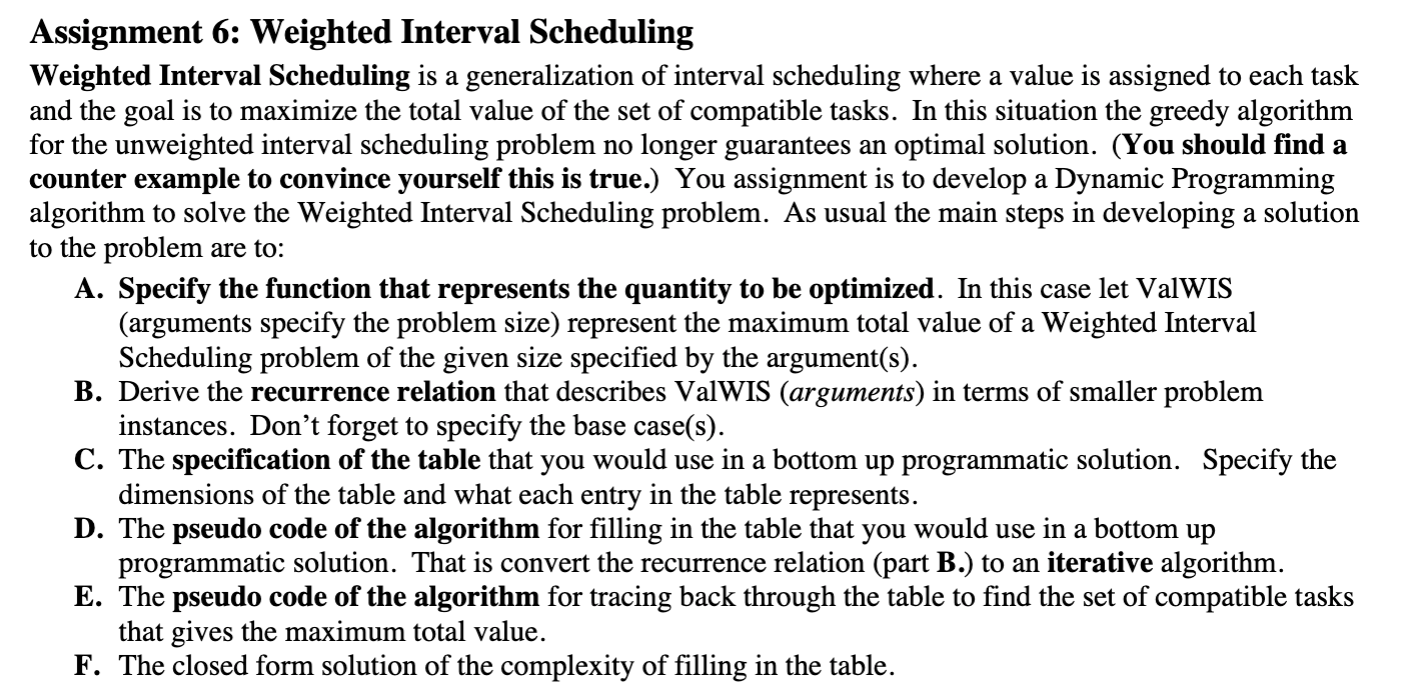Answered step by step
Verified Expert Solution
Question
1 Approved Answer
A-F in java please. Thank you. Assignment 6: Weighted Interval Scheduling Weighted Interval Scheduling is a generalization of interval scheduling where a value is assigned

A-F in java please. Thank you.
Assignment 6: Weighted Interval Scheduling Weighted Interval Scheduling is a generalization of interval scheduling where a value is assigned to each task and the goal is to maximize the total value of the set of compatible tasks. In this situation the greedy algorithm for the unweighted interval scheduling problem no longer guarantees an optimal solution. (You should find a counter example to convince yourself this is true.) You assignment is to develop a Dynamic Programming algorithm to solve the Weighted Interval Scheduling problem. As usual the main steps in developing a solution to the problem are to: A. Specify the function that represents the quantity to be optimized. In this case let ValWIS (arguments specify the problem size) represent the maximum total value of a Weighted Interval Scheduling problem of the given size specified by the argument(s). B. Derive the recurrence relation that describes ValWIS (arguments) in terms of smaller problem instances. Don't forget to specify the base case(s). C. The specification of the table that you would use in a bottom up programmatic solution. Specify the dimensions of the table and what each entry in the table represents. D. The pseudo code of the algorithm for filling in the table that you would use in a bottom up programmatic solution. That is convert the recurrence relation (part B.) to an iterative algorithm. E. The pseudo code of the algorithm for tracing back through the table to find the set of compatible tasks that gives the maximum total value. F. The closed form solution of the complexity of filling in the table. Assignment 6: Weighted Interval Scheduling Weighted Interval Scheduling is a generalization of interval scheduling where a value is assigned to each task and the goal is to maximize the total value of the set of compatible tasks. In this situation the greedy algorithm for the unweighted interval scheduling problem no longer guarantees an optimal solution. (You should find a counter example to convince yourself this is true.) You assignment is to develop a Dynamic Programming algorithm to solve the Weighted Interval Scheduling problem. As usual the main steps in developing a solution to the problem are to: A. Specify the function that represents the quantity to be optimized. In this case let ValWIS (arguments specify the problem size) represent the maximum total value of a Weighted Interval Scheduling problem of the given size specified by the argument(s). B. Derive the recurrence relation that describes ValWIS (arguments) in terms of smaller problem instances. Don't forget to specify the base case(s). C. The specification of the table that you would use in a bottom up programmatic solution. Specify the dimensions of the table and what each entry in the table represents. D. The pseudo code of the algorithm for filling in the table that you would use in a bottom up programmatic solution. That is convert the recurrence relation (part B.) to an iterative algorithm. E. The pseudo code of the algorithm for tracing back through the table to find the set of compatible tasks that gives the maximum total value. F. The closed form solution of the complexity of filling in the tableStep by Step Solution
There are 3 Steps involved in it
Step: 1

Get Instant Access to Expert-Tailored Solutions
See step-by-step solutions with expert insights and AI powered tools for academic success
Step: 2

Step: 3

Ace Your Homework with AI
Get the answers you need in no time with our AI-driven, step-by-step assistance
Get Started


